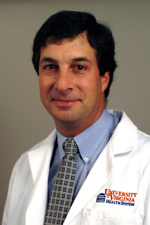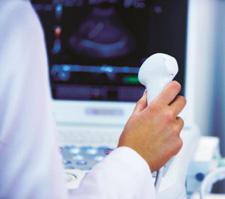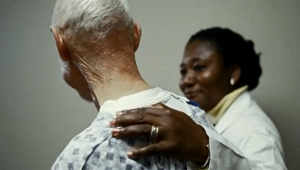Clinical | Quality & Safety
THE CLINICAL MISSION:
Innovations in Patient Care
The Department of Medicine and its more than 240 clinical faculty are privileged to serve the people of the Charlottesville-Albemarle region, as well as thousands from elsewhere in Virginia and many other states. The department’s clinical care partners include University Medical Associates, University Physicians Charlottesville and University Physicians Orange.
The new eConsults program seeks to address the gap between available specialists and the need for specialty care by using technology to increase the availability of additional specialist appointments for patients with complex medical conditions. eConsults allows specialists to quickly answer straightforward patient questions and concerns that may not require an appointment; additionally, through eConsults, primary care physicians can ask specialists brief questions about a patient, sending a message through EpicCare. The specialist can review the patient’s medical history before making a recommendation. In many instances, this saves the patient time and expense but, conversely, it can help identify patients that need to be seen by a specialist for their care.
Expanding the Clinical Footprint
UVA Health System and Bon Secours Health System signed a nonexclusive agreement in January 2015 to create and expand partnerships in cardiovascular services, cancer, physician recruitment, population health, patient safety and undergraduate and graduate medical education. The heart care partnership included the introduction of transcatheter mitral valve repair to Bon Secours St. Mary’s Hospital in Richmond, and an academic affiliation between Bon Secours and UVA School of Medicine that enables UVA medical students to perform clinical rotations at Bon Secours facilities in Richmond as part of their education.
The most recent addition to the Department of Medicine’s service locations is the UVA Primary and Specialty Care Pantops Integrative Medicine, a collaborative initiative with the UVA Department of Family Medicine. The clinic includes multiple providers and allied healthcare providers whose goal, says Alan Dalkin, MD, Department of Medicine vice chair, is “to develop a practice focusing on integrative medicine in the primary and specialty care setting.”
According to Dr. Dalkin, the growth in the Department of Medicine’s clinical faculty over the last year has in no small measure driven the expansion of clinical services:“We added over a dozen superb new faculty members [in FY 2015], representing many of the medical care service lines, from general medicine through the subspecialties,” Dr. Dalkin says. “Particular areas of growth have been in general medicine, gastroenterology, cardiology, infectious disease and endocrinology. The department continues to actively recruit new faculty in a number of clinical areas, including the Division of Pulmonary and Critical Care Medicine and the Division of Rheumatology.”
Expansion of outpatient (ambulatory) clinics and services continues to be a departmental goal, says Dalkin. “We have great expertise in our department and being able to provide consultative care on demand for our partners in healthcare and their patients is a win-win proposition.” The Division of Allergy & Immunology’s new clinic for Primary Immune Deficiency Diseases (PIDDs), located at UVA Medical Park Northridge and staffed by Monica Lawrence, MD, and Larry Borish, MD, is but one example. At UVA Culpeper Hospital, efforts are underway to bolster the connections with providers in Charlottesville, and technological resources such as telemedicine are increasingly being utilized to provide rapid consultative services for hospitalized patients.
Leading Change at UVA Health System
The provision of primary care and the practice of internal medicine are undergoing rapid change — and the Department of Medicine continues to be on the front lines. The reorganization of its primary care practices along the lines of the “primary care medical home” model and the transition of the entire medical center to an “accountable care organization” model, with key leadership from DOM faculty, are important examples.
Department of Medicine faculty are playing a leading role, as well, in two ongoing efforts of UVA Health System: the Be Safe campaign and the Rounding with Heart initiative. The goal of “Be Safe” is to make UVA the safest hospital in America, by empowering front-line healthcare workers and other team members — from the bedside nurse to environmental services personnel — to identify and call out safety and quality issues. When these arise, a real-time process is triggered that includes leadership support and immediate access to institutional resources.
Rounding with Heart focuses on clinical excellence and addresses a host of care delivery issues by ensuring that caregivers from various disciplines who are treating a patient gather at the patient’s bedside daily, and that the patient and his/her family members are included in key decisions.
Recently Added Clinical Services
Recently established clinics or services include (more about these and others in the sidebar at right):
- Inpatient glucose management program.
- Fecal microbiota transplant program.
- Orthopedics co-management by the hospitalist team.
- Transplant infectious disease service.
- Fully staffed 24/7 hospitalist service.
- Enhancement of multidisciplinary oncology services
With leadership from George Hoke, MD, head of the Division of General Medicine’s Hospital Medicine section, and from Clint Merritt, MD, its medical director, the hospitalist group has established a Transfer Center for University Hospital, which coordinates physician referrals and patient transfers. Hospitalists field transfer requests for patients who will be placed in general medicine, gastroenterology, cardiology, hematology-oncology and plastic surgery units; they also obtain clinical updates for general medicine patients who must wait more than 24 hours for transfer. These processes ensure a more coordinated transition of care.
New Services & Procedures
– Inpatient Glucose Management (IGM) Consult Service: Launched in FY 2014 by Jennifer Kirby, MD, and Anthony McCall, MD, (Division of Endocrinology), this service provides expertise for the care of diabetic patients who have just undergone cardiovascular surgery, and has resulted in significantly improved outcomes, as shown in the table on this page.
– Living Donor Liver Transplant Program (LDLT): Directed by Curtis Argo, MD, (Gastroenterology & Hepatology), the LDLT program has experienced remarkable growth, thanks to the LDLT Donor Champion initiative, which helps recipients and their families identify a “primary advocate” — someone who takes the lead in identifying potential living donor candidates. Since the Donor Champion initiative was launched, the number of intakes for donor candidates processed by the LDLT program has tripled. And in 2015, the LDLT program had a first: a living donor transplant that involved a nondirected, “altruistic” donor.
– Musculoskeletal Ultrasound (MSUS) Service: Offered by the Division of Rheumatology, ultrasound imaging allows for rapid, noninvasive diagnostic evaluation for a variety of inflammatory and noninflammatory musculoskeletal conditions affecting structures outside of the spine.
– Orthopedic Co-Management Service: Hospitalists are assigned to assess and triage patients presenting in the Emergency Department with orthopedic disorders; they perform preoperative evaluations, assume responsibility for management of chronic medical comorbidities and acute complications, and assist in care transitions at the time of discharge.
– Stem Cell Transplant Program (Division of Hematology-Oncology): The program was approved for matched unrelated allogeneic stem cell transplants by the National Marrow Donor Program; it also achieved accreditation from the Foundation for the Accreditation of Cellular Therapy (FACT).
– Transitional Extracorporeal Care Unit (Division of Nephrology): Provides outpatient dialysis for discharged patients who require continued hemodialysis following acute kidney injury.
Innovations in Patient Care
– Blue Ridge PACE (“Program for All-Inclusive Care for the Elderly”): Established in March 2014 and directed by Mark Newbrough, MD, (Division of General Medicine), Blue Ridge PACE has grown steadily, with current enrollment at 74. PACE is a federally funded initiative of the Centers for Medicare & Medicaid Services (CMS); an initial CMS survey of Blue Ridge PACE, conducted in November 2014, found it to be “deficiency-free” and the program on track in terms of census growth and quality of care.
– “CARE Track” Program: Funded by a CMS Innovation Award, CARE Track was launched by the Palliative faculty in the Division of General, Geriatric, Palliative & Hospital Medicine. Aimed at transforming the care of patients with advanced cancer by utilization of UVA “MyCourse” — an outcome tool in which patients fill out a questionnaire at the end of each visit — the program produces symptom and functional status metrics. These data are incorporated in the patient’s EMR in real time, triggering alerts to providers for those with worsening symptoms or declining functional status. This intervention has resulted in significant decreases in hospitalizations at the end of life.
– Leukemia Care Program: Directed by Michael Douvas, MD (Hematology-Oncology), the aim of the program is to integrate and coordinate the complex services needed for treatment of leukemias, including induction therapies, novel agents, and cellular therapies such as stem cell transplantation.



